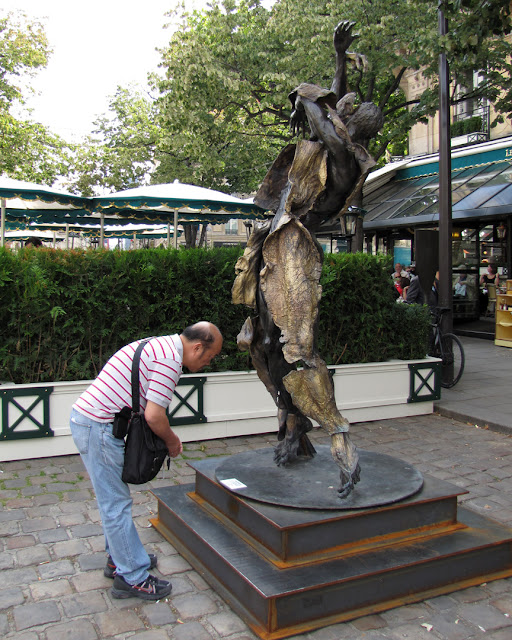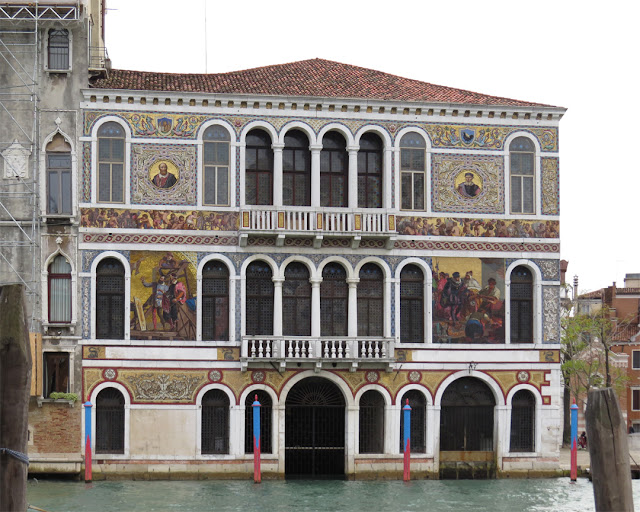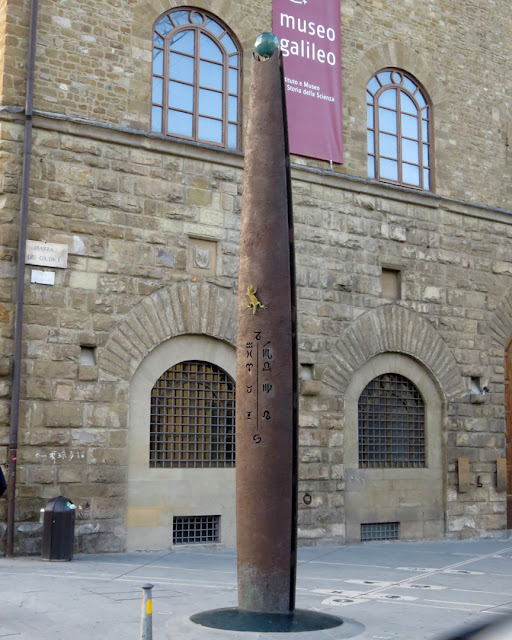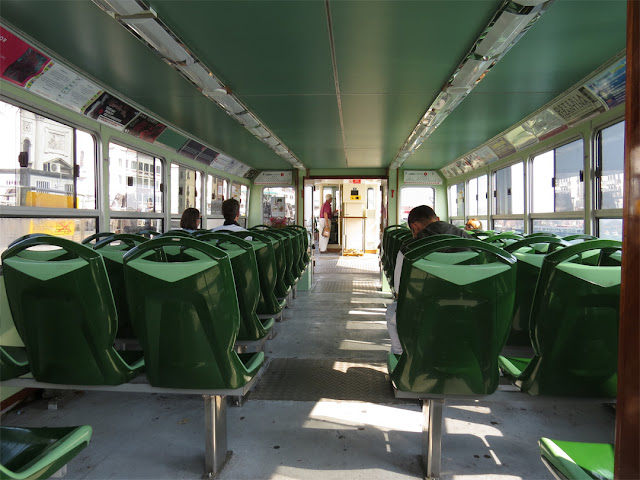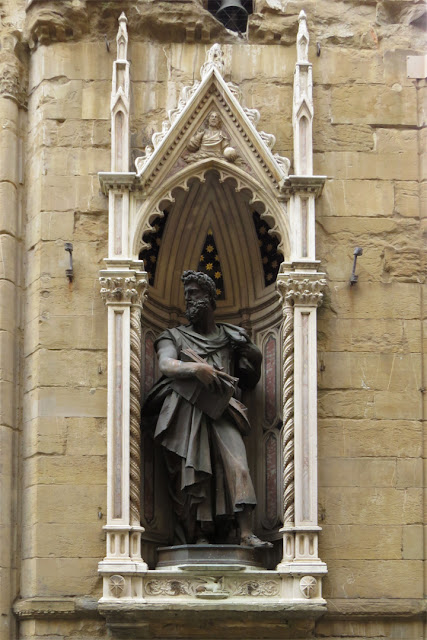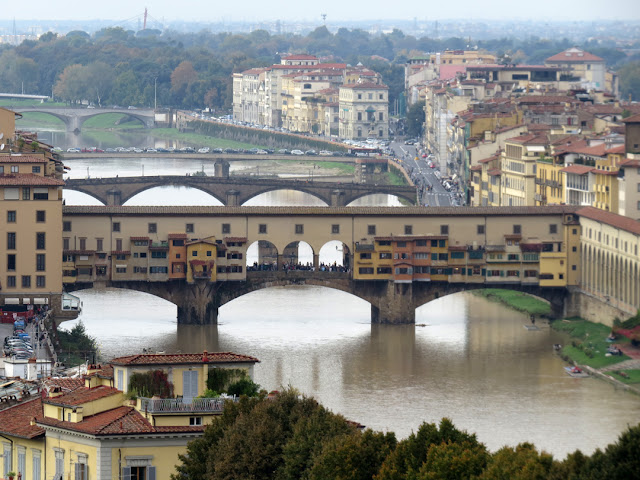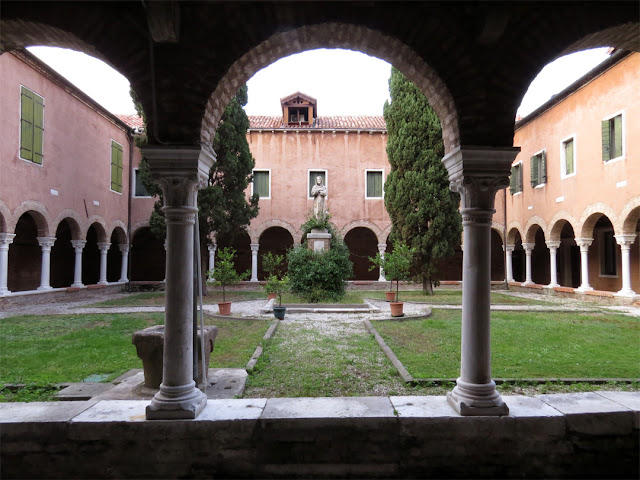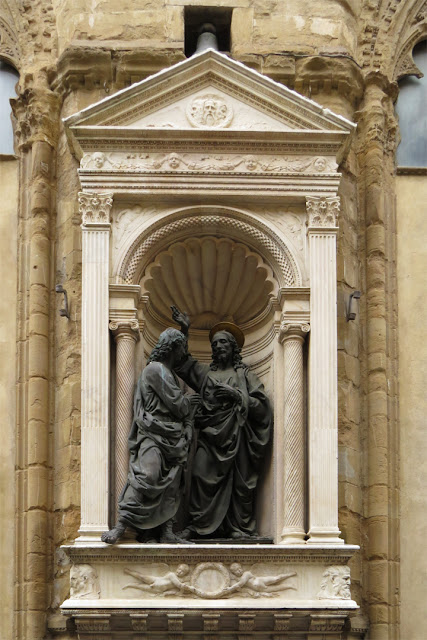Tuesday, December 31, 2013
Monday, December 30, 2013
Fountain of Juno
Fountain of Juno by Bartolomeo Ammannati
Museo Nazionale del Bargello
Via del Proconsolo
Florence, October 2013
“A year after Giorgio Vasari had entered the services of Duke Cosimo I de’ Medici, Bartolomeo Ammannati returned to Florence. He was ordered to carve a fountain for the great hall of the Palazzo Vecchio where the audiences took plane. The fountain was planned for the west wall of the Udienza, across from Bandinelli’s set of statues in niches flanked by columns, and it was to be a pendant consisting of marble and bronze statues as well as columns. The initial plans of a wall fountain for the palace were transformed by Ammannati. Michelangelo’s advice was sought and, finally in his letter of 25th April 1560 to Duke Cosimo, he gave his approva] to Ammannati's ideas underlining the beautiful fantasy of the setting. Ammannati carved a multi-wiewed fountain which included six allegorical, life size figures, two peacocks, and a marble rainbow. The oval-shaped fountain showed Juno suited upon the rainbow and flanked by the peacocks, her attribute, Ceres standing in the centre with the rainbow resting on her head, with Florence and Temperance at her sides analogously standing, and the latter statues were accompanied by reclining figures, the river Arno and the fountain Paruassus. This fountain visualized ‘il generare dell'acqua’ as Raffaello Borghini put it.” (A note on the chronology of Ammarmati’s Fountain of Juno, Hildegard Utz)
Sunday, December 29, 2013
Arco del Paradiso
Arco del Paradiso (Arch of Paradise)
Ponte del Paradiso / Calle del Paradiso
Venice, September 2013
“On the side of the arch facing the street, the Madonna protects two worshipers, a nobleman and a woman. The coats of arms on the sides of the Madonna belong to the Foscari (a lion) and Mocenigo families (two flowers). On the side facing the bridge, the Madonna protects one worshiper, a friar. Only the coat of arms of the Foscari family is displayed on this side, twice, one on each side of Mary. The origin and date of this arch are controversial. Some historians believe that the Foscari family commissioned the arch to celebrate the marriage of Pellegrina Foscari and Alvise Mocenigo which took place in 1491. This would date the arch as late XV century. However, the arch is clearly Gothic and more in the style of the XIV or early XV century. In addition, the coat of arms of the Foscari family is next to the man and that of the Mocenigo family next to the woman, contradicting the notion that the woman represents a Foscari and the man a Mocenigo. According to the records, the two houses next to the bridge were rebuilt by the abbot of the church of Santa Maria della Pomposa (near Ravenna) and in 1407 passed to the Foscari and Mocenigo families. According to other historians, the arch would commemorate this event. The image of the friar on the bride side seems to confirm this idea. This would date the arch as early XV century. To add just one more sliver of confusion, a plaque near the arch reads: ‘Arte Gotica, s. XIV’” (Calle del Paradiso, A Lover of Venice)
Saturday, December 28, 2013
World of Disney
World of Disney store
Fifth Avenue
New York, October 2007
“When critics write that Picasso was the most influential artist of the twentieth century, they forget Disney. His influence has operated at a number of levels for eighty years now, and one suspects it is only just beginning. That Disney was an artist is unquestionable, and part of the Modern Movement too, for the influence of Futurism on his early cartooning is obvious. A study of his Alice's Wonderland (1923) is instructive about his voracious artistic appetite and vocabulary. But Disney was a businessman of genius, and in his own way a moral force. Unlike Picasso, he was incapable of cynicism and his sincerity, like Della Robbia's, radiates from every line he drew. His masterpiece Snow White and the Seven Dwarfs (1937) is not only a highly inventive piece of animation but the Ur-document of a school which had branched out into over two hundred different systems of animated cartooning by the end of the century. Disney himself trained over a thousand artists, almost as many as the Académie Julian. Cartoons were the basis of most fashion art during the second half of the century and they also had a direct influence on clothes, interior decoration, furniture and architecture. Post-Modernism is part of Cartoon Land.” (Paul Johnson, Art: A New History)
Friday, December 27, 2013
Fixing the Louvre
Maintenance crew at work
Cour Carrée (Square Courtyard)
Palais du Louvre (Louvre Palace)
Quartier Saint-Germain-l'Auxerrois, 1st arrondissement
Paris, July 2012
Thursday, December 26, 2013
Dancing in the Academy
Dancing in the Galleria dei Prigioni (Prisoners' Hall)
Galleria dell'Accademia
Via Ricasoli
Florence, October 2013
“Used in the nineteenth century for the display of ancient paintings from the collections of museum, the Galleria was later altered to house several very important sculptures by Michelangelo, thus creating a specific and unified itinerary that culminates in the centre of the Tribune where the statue of David stands.
The Galleria takes its name from the four large sculptures showing male nudes known as the Slaves or Prisoners. They were begun by Michelangelo for the tomb of Pope Julius II which was to have been built in the Basilica of St. Peter's in Rome. Left unutilised, after the death of Michelangelo they were presented to the Grand Duke of Tuscany, Cosimo I, who placed them in the Grotta del Buontalenti in the Boboli Gardens in Florence, where they remained up to 1909.” (Galleria dei Prigioni, Galleria dell'Accademia)
Wednesday, December 25, 2013
Cometa di Vetro
“Cometa di Vetro” (Glass Comet) by Simone Cenedese
Campo Santo Stefano
Murano, Venetian Lagoon
Venice, September 2013
Tuesday, December 24, 2013
Zentrale Wandelhalle
Zentrale Wandelhalle (Central Hall)
Gemäldegalerie
Matthäikirchplatz, Kulturforum
Berlin, September 2011
“The paintings in the collection have been on show in their present home at the Kulturforum since 1998. The design proposals for the Gemäldegalerie’s new building were submitted in an architectural competition in 1986, with the contract awarded to the architects Hilmer & Sattler the following year. With distinctly Prussian austerity of expression, the simple building rises above the sloping piazzetta, while inside its individual galleries are grouped around a light-filled central hall.” (Gemäldegalerie, Official Website)
See also: Gemäldegalerie Skylight - Greyscale
Monday, December 23, 2013
Vanity
“La vanité mise à nue par ses thuriféraires” by Daniel Hourdé, 2009
Place Saint-Germain-des-Prés
Quartier Saint-Germain-des-Prés, 6th arrondissement
Paris, July 2011
“La vanité mise à nu par ses thuriféraires is another thought-provoking sculpture by Daniel Hourdé, installed just across the road from Désillusion totale, that perfectly represents the stripping of vanity to reveal the fundamentals, the depth beneath this layer of superficial mask. We are vulnerable under it all; usually only the most devoted see this side of us, with the truest standing by us unconditionally. Trust of this kind is hard to come by and if you have earned it, never take it for granted.” (Daniel Hourdé around St-Germain, Lil & Destinations…)
Sunday, December 22, 2013
Michelangelo's Tomb
Tomb of Michelangelo Buonarroti by Giorgio Vasari
Basilica di Santa Croce (Basilica of the Holy Cross)
Piazza Santa Croce
Florence, October 2013
“Michelangelo died at Rome in 1564. The general design of his tomb, which we are now examining, was by Vasari. The bust of the great master, seen above the central figure, is by Battista Lorenzi, and, if a good likeness, does not show Michelangelo to have been a very handsome man. The figure of architecture - the one on the right - is by Giovanni dall'Opera. The central figure represents Painting and is by Lorenzi ; while the third represents Sculpture and was executed by Cioli.” (Michelangelo's Tomb, Michelangelo Models)
Saturday, December 21, 2013
House of the Seven Chimneys
Casa dei Sette Camini (House of the Seven Chimneys)
Fondamenta Tron, Dorsoduro
Venice, September 2013
“Across the canal are the natural sciences laboratories of the Ca' Foscari University and beyond, the Santa Marta quarter housing complex. This used to be one of the poorest sections of Venice. The first inhabitants were fishermen that made a meager living off the lagoon and these humble origins are still reflected in the name of their church, San Nicolò dei Mendicoli, Saint Nicholas of the Beggars. On Rio de le Terese, Fondamenta Tron, a few yards away from the church, is the House of the Seven Chimneys (Casa dei Sette Camini) built in the 1700's as a housing project. It underwent a major retrofit in 1995-1996.” (Around Dorsoduro, A Lover of Venice)
Friday, December 20, 2013
Thursday, December 19, 2013
VAB Azure
VAB AZURE (Action en Zone URbaine) - Urban warfare vehicle
Véhicule de l'Avant Blindé (Armoured Vanguard Vehicle)
Just before the Bastille Day military parade
Avenue de Wagram
Quartier du Faubourg-du-Roule, 8th arrondissement
Paris, July 2012
“VAB AZURE (Action en Zone URbaine) - Urban warfare vehicle equipped with a dozer blade and with panoramic periscopes to observe and monitor.” (Véhicule de l'Avant Blindé, Wikipedia)
Wednesday, December 18, 2013
Nicola Demidoff
Monument to Nicola Demidoff (Nikolai Nikitich Demidov) by Lorenzo Bartolini
Piazza Demidoff
Florence, October 2013
“Nikolai Demidov served as chamberlain to the Tsar, a Hereditary Commander of the Order of Saint John of Jerusalem, and member of the privy council. In 1819 he was made Russian ambassador to the court of Tuscany. After divorcing his wife, who moved back to France, he lived his last years in France and Italy among scholars, financing the creation of schools, hospitals and other charitable institutions in Tuscany. He bought 42 acres (170,000 m2) of marshland north of Florence from the Catholic Church and there built the Villa San Donato from 1827 to 1831 (now destroyed), where he set up richly-decorated private rooms, a suite of 14 rooms housing his enormous art collection, a theatre and a foreign languages academy. That collection, reputed among the most lavish private collections in Europe, was divided between his residences in San Donato, Saint-Petersburg, Paris and Moscow, included works by Flemish and Italian masters, decorative art objects and a famous collection of weapons now in the Wallace Collection in London. His collection of ancient Greek and Roman sculptures is now at the Hermitage Museum. By decree of Leopold II, Grand Duke of Tuscany, on 23 February 1827 Demidov was made ‘count of San Donato’ for the services he had rendered to Tuscany by setting up a silk factory. A public Monument to Nicola Demidoff designed by Lorenzo Bartolini is located on ‘Piazza Demidoff’ overlooking the river Arno in Oltrarno.” (Nikolai Nikitich Demidov, Wikipedia)
Tuesday, December 17, 2013
Synagogues of Europe
Synagogues of Europe poster by The Studio Michal Meron
Venetian Ghetto, Cannaregio
Venice, September 2013
External links: Synagogues around the world by Michal Meron's Studio
Monday, December 16, 2013
Seven Pillars of Wisdom
The “Seven Pillars of Wisdom” rock formation
Wadi Rum (The Valley of the Moon)
Jordan, May 1995
“The cliff currently called the ‘Seven Pillars of Wisdom’ is at the entrance to the Wadi Rum. The new ‘Gate’ to the Wadi Rum protected area is close beside it, and the new Visitors' Centre looks out over it. Just behind this jebel is Jebel Um Ishrin. Most people assume that T.E. Lawrence's book was named after this cliff. In fact the reverse is true, and the name has only become generally accepted locally in the last 10 years or so. If you count the ‘pillars’ carefully, you will only find 6 of them!” (Wadi Rum, Ruth Caswell)
Sunday, December 15, 2013
The Age of Bronze
The Age of Bronze (L'Âge d'airain) by Auguste Rodin
Place Rodin
Quartier d'Auteuil, 16th arrondissement
Paris, July 2012
Saturday, December 14, 2013
Fontana del Carciofo
Fontana del Carciofo (Fountain of the Artichoke) by Francesco Susini, 1639
Palazzo Pitti
Florence, October 2013
“Once inside the main entrance of Pitti Palace, one passes through the wide Ammannati courtyard, closed off on three sides by the inner façades of the building and on the fourth by a single storey topped by the Artichoke Fountain (Fontana del Carciofo, 1639-41), the work of Francesco Susini.” (Pitti Palace - The Official Guide, Marco Chiarini)
Friday, December 13, 2013
Palazzo Barbarigo
Palazzo Barbarigo, Campo San Vio
Seen from the Canal Grande (Grand Canal)
Venice, September 2013
“Palazzo Barbarigo was originally built in the 16th century. Its architecture follows the Renaissance style and consists of three levels: an open loggia which gives access to the canal, a first floor with open loggias, decorated columns and a second floor above this. The modern mosaics, which were added later on, probably covered some of the original windows and obscured the original design. Not much information is available on the early history of Palazzo Barbarigo except that the Murano mosaics were added in 1886. When Palazzo Barbarigo became the headquarters of Pauly & C. – Compagnia Venezia Murano, a leading Venetian company that produced glass art, the company employed master glass workers to decorate the facade of the Renaissance palazzo with complex mosaic designs. They took the idea from the exterior mosaics on the facade of St Mark’s Basilica.” (Palazzo Barbarigo, Travel Signposts)
Thursday, December 12, 2013
Berlin Hauptbahnhof
Berlin Hauptbahnhof (Berlin Central Station)
Europaplatz
Berlin, September 2011
See also: Berlin Central Station - Inside Berlin Hauptbahnhof - Rolling Horse
Wednesday, December 11, 2013
Sotto Sopra
Chairs and tables outside Sotto Sopra (Upside Down)
Rue des Archives
Quartier des Archives, 3rd arrondissement
Paris, July 2012
Tuesday, December 10, 2013
Monumental Sundial
Monumental sundial by Filippo Camerota, Luise Schnabel, Giorgio Strano
Outside the Museo Galileo
Piazza dei Giudici
Florence, October 2013
“Conceived as a ‘mathematical ornament’ for the Institute and Museum of the History of Science, the sundial indicates true solar time for the place where it is located. The shadow cast by the glass globe atop the large bronze gnomon indicates the date and time. The hours from 9:00am to 2:00pm are marked out by radial brass lines while the date is indicated by the travertine traversal lines which signal the Sun’s diurnal course for various periods of the year – precisely when the star enters the signs of the Zodiac. The shadow cast by the gnomon changes in length during the course of the days and seasons, and indicates a different time than that of our wristwatches. In respect to true solar time, mean time indicated by our wristwatches has a periodic variation that during the course of a year can exceed a quarter of an hour. Moreover, when it is daylight saving time, during the spring and the summer, the hands of a clock are moved forward one hour. For example, true midday in the month of February would be indicated by the sundial around 12:28 pm while in the month of July it would be indicated around 13:20 pm daylight saving time.” (The sundial, Museo Galileo)
Monday, December 9, 2013
Inside a Vaporetto
Inside a “vaporetto” (water bus) of the Linea 2 (Route 2)
San Zaccaria boat stop, Bacino San Marco
Venice, September 2013
Sunday, December 8, 2013
Nelson Mandela
Statue of Nelson Mandela by Ian Walters, 2007
Parliament Square
London, October 2009
“It's easy to pinpoint the problem with Ian Walters's 9ft bronze statue of Nelson Mandela. It's the hands. They're too big. Walters, who died last summer before the work could be cast, has chosen to depict the former South African president mid-speech, hands scything the air to underpin his rhetoric. So while the face may be an acceptable likeness, the oversize, puffy fingers draw too much attention to themselves, over-emphasising the gesture.
As a result, Mandela looks like he is ever so slightly dizzy and reaching out for balance. The effect, unfortunately, is less elder statesman, more unsteady granddad, which is unjust for such an historically important figure. No wonder Charles Saumarez Smith, the former director of the National Gallery, was so scathing when it was announced that Walters would undertake the commission. ‘He [Walters] is not regarded by anyone, even including the supporters of the project, as a sculptor of any public distinction or artistic merit,’ wrote Saumarez Smith. Sadly, the finished cast of Walters's statue has not proved him wrong: it feels lumpish and clumsy. The best you can say about it is that it's mounted on a surprisingly low plinth. This brings Mandela closer to his viewers - appropriately enough for a figure so indelibly associated with democracy.” (Clumsy tribute to a great man by Alastair Sooke, The Telegraph)
Saturday, December 7, 2013
Charging the Eiffel Tower
“La France Renaissante” by Holger Wederkinch, 1930
Pont de Bir-Hakeim, Île aux Cygnes
Paris, July 2012
“It was made in 1930 by the Danish sculptor, Holger Wederkinch, and given as a gift to Paris by the Danish community. Originally, the rider on the horse was supposed to represent Joan of Arc. But the character of the figure was judged to be too emphatic and war-like, contrary to the iconography at that time of this heroine. It was not appreciated by the Paris city council, who issued an unfavorable opinion about it in 1956. To avoid a diplomatic incident, Denmark’s embassy decided to rename the statue ‘La France Renaissante,’ making it simply a decorative statue. The erection of the statue in the Place was authorized later in 1956, and it was inaugurated on that spot in 1958, in the presence of the Danish ambassador.” (Saturday, July 30, 2011, Barbara Cooley's Paris Journal)
Friday, December 6, 2013
San Luca
San Luca (Luke the Evangelist) by Giambologna, 1601 (copy)
Orsanmichele, Via dei Calzaiuoli side
Florence, October 2013
“The exterior of the church is infinitely interesting - decorated with niches containing statues of saints commissioned by the various guilds of Florence (along with other carvings and architectural decorations). Fourteen guilds, including the silk workers, bankers, and the blacksmiths are represented. Although the program began during the late middle ages, the sculptures were not begun in earnest until the early fourteenth century. As a result, the entire range of Renaissance sculpture is represented, from the Early - Ghiberti's St. John the Baptist of 1414 (the first life-sized bronze cast in the Renaissance) - to the Late Renaissance - Giambologna's Saint Luke of 1601. All of the original works have been removed for restoration and replaced by copies.” (Sculptures of Orsanmichele, Orsanmichele)
See also: Christ and St. Thomas - Madonna delle Grazie Altar - San Matteo - Santo Stefano
Thursday, December 5, 2013
Santa Bibiana Mosaic
The Santa Bibiana Mosaic, 400
Sala caldaie (Boiler room) of the former Montemartini power plant
Centrale Montemartini
Via Ostiense
Rome, April 2013
“The interior also preserves the historic architecture of the power plant, with massive iron steps leading to an upper platform that was once used to oversee the generators but is now another element in the cinematic scene. You can mount the stair to look down upon the ancient mosaic floor with its hunting scenes, for instance. The vast windows of the former plant allow for natural light to flood the space, and the clouds in the sky seem to be another artwork.” (Centrale Montemartini, anothertravelguide.com)
Wednesday, December 4, 2013
Washington Irving
Bust of Washington Irving by Friedrich Beer, 1885
Outside Washington Irving High School
Irving Place
New York, September 2008
“They also contain one of the most extensive art projects in a New York City public school, with four separate mural projects and sculpture contributed by two additional artists. In addition to these works commissioned specifically for the high school, a bust of Washington Irving by Friedrich Beer was placed in front of the building in 1935.” (Washington Irving High School, Preserve & Protect)
Tuesday, December 3, 2013
Scruffy Sparrow
Scruffy sparrow resting on a plant
Jardin du Luxembourg
Quartier de l'Odéon, 6th arrondissement
Paris, July 2011
Monday, December 2, 2013
Bridges of Florence
The Ponte Vecchio with the Ponte Santa Trinita almost hidden behind
Ponte Amerigo Vespucci, Ponte alla Carraia
Ponte alla Vittoria, Ponte della Tramvia
(One of the towers of the Ponte dell'Indiano is also visible beyond the trees)
Florence, October 2013
Sunday, December 1, 2013
San Francesco della Vigna
The cloister of San Francesco della Vigna
Campo San Francesco della Vigna
Venice, September 2013
“The name ‘della Vigna’ is derived from a wineyard documented in several 13th century documents concerning the noble Ziani family, who lived in a ‘palatium’ in the near parish of Santa Giustina. Still today, despite later urbanisation, the area is characterised by green space.” (Campo San Francesco della Vigna, Architecture of Venice)
Saturday, November 30, 2013
Hans Joachim von Zieten
General der Cavallerie (General of the Cavalry) Hans Joachim von Zieten
Marble original by Johann Gottfried Schadow, 1794
Bronze copy by August Kiss, 1857
Zietenplatz
Berlin, September 2011
“The central section extending to Mauerstraße was called Zietenplatz from 1849 until 1945. The name comes from the statue unveiled in 1794 of the Cavalry General Hans Joachim von Zieten. It formed a unique ensemble of monuments on the square area together with five other statues of generals. Today, the building for representatives of the Province of Thuringia is on the northern corner towards Mauerstraße. The monument of the Hussar General von Zieten was erected again in 2003, followed by the sculpture of the Old Dessauer on 8 June 2005. The newly designed Zietenplatz, based on a design by the landscape architect Reinald Eckert, Berlin was presented to the public in June 2007.” (Zietenplatz and Hausvogteiplatz, Berlin.de)
Friday, November 29, 2013
Raoul Follereau
Raoul Follereau by Dominique Kaeppelin, 1984
Place Raoul-Follereau
Quartier de l'Hôpital-Saint-Louis, 10th arrondissement
Paris, July 2012
L’apôtre des lépreux
(The Apostle of the Lepers)
Personne n'a le droit d'être heureux tout seul
(No one has the right to be happy by themselves)
“In 1936, the director of an Argentine newspaper asked him to go to Sahara region to tread Father de Foucauld's steps, whose 20th anniversary of death was about to be celebrated. It was during one of these travels that Follereau met the leprosy-affected persons for the first time. In the following ten years he traveled the world many times, holding 1200 conferences which allowed him to support the building of Adzopé in Ivory Coast, the town of the leprosy affected persons.” (Raoul Follereau - A Brief Biography, AIFO)
Thursday, November 28, 2013
Michelangelo's David
David by Michelangelo, 1504
Galleria dell'Accademia
Via Ricasoli
Florence, October 2013
“Michelangelo took three years to finish his David. This great work would confirm him as even more than just Florence's greatest sculptor. What the Florentines saw that day in 1504, was a masterpiece with no equal. A giant almost four and a half meters high and the only large nude sculpted after ancient times, as no-one had previously dared to challenge the Greek and Roman masterpieces. But though it does remind us of ancient models, the David sculpture is daringly anti-classical. Its position, though expressing perfect balance, alludes at movement, with its left heal raised off the ground. The attitude is strong, arrogant and, above all, filled with inner life like no other similar classical statue. Behind the apparent equilibrium, his David represses strong energy and tension.” (Michelangelo's David, ItalyGuides.it)
Wednesday, November 27, 2013
I Piombi
The former prison of “I Piombi” (The Leads)
Palazzo Ducale (Doge's Palace)
Venice, September 2013
“The famous Piombi were housed in rooms under the roof. They owe their name to the slabs of lead that covered the roofs, making these rooms extremely hot in summer and ice-cold in winter. These rooms were in general, designated to upper-class inmates or to those awaiting trial. The most famous guest of the Piombi was Giacomo Casanova, who ended up in prison after a long series of crimes and was the protagonist of the most famous and fantastical of escapes: having climbed onto the prison roof, Casanova managed to slide down a drain pipe, slip inside the Palace and then persuade someone to open the door, in order for him to then escape calmly on a gondola. Not, according to legend, without first allowing himself a coffee in the Piazza San Marco.” (Prisons, Doge's Palace, ItalyGuides.it)
Tuesday, November 26, 2013
Monday, November 25, 2013
Interdiction d'accès
No entry sign amended by Clet Abraham
Place du Marché-Saint-Honoré
Quartier de la Place-Vendôme, 1st arrondissement
Paris, July 2012
See also: Clet Abraham - Common Man
External links: Clet Abraham (Livorno Daily Photo)
Sunday, November 24, 2013
Basilica di San Marco
Basilica di San Marco
Piazza San Marco
Florence, October 2013
(On the ceiling: Assunzione della Vergine by Giovanni Antonio Pucci, 1725)
“The church was consecrated in 1443 and became since then on an important hive of activity in the fields of religion, thinking and art which some of its friars were involved in. One of them was Fra Angelico, who began painting at 17 and became a member of the order at 18. He lived in the monastery from 1436 to 1445. The others were St. Antonino da Firenze, Archbishop of Florence, who stayed in the monastery between 1446 and 1459, and then the theologian and thinker Fra Girolamo Savonarola, who became monastic prior in 1491 and, between 1494 and 1498, ruled the Republic of Florence. He died at the stake as the Inquisition Court had believed him guilty of heresy.” (Basilica di San Marco, Divino Villas)
Saturday, November 23, 2013
Do Not Feed the Pigeons
“Non dare da mangiare ai colombi” (Do not feed the pigeons) sign on a bin
“Causano problemi sanitari e danni ai monumenti”
(They cause health problems and damage to the monuments)
Piazzetta di San Marco
Venice, September 2013
“Pigeons attract idiots. Look at this American woman in the Piazza San Marco, Venice. She’s in one of the most beautiful parts of one of the world’s loveliest cities and she’s fascinated by the pigeons. She’s clearly an idiot. She could be looking at the Basilica, she could be looking at the Doge’s Palace, she could be looking at the Procuratie Vecchie but no, she’s looking at pigeons.” (7 Reasons to Hate Pigeons, 7reasons.org)
Friday, November 22, 2013
African Burial Ground
African Burial Ground National Monument by Rodney Léon
Duane Street
New York, September 2008
For all those who were lost
For all those who were stolen
For all those who were left behind
For all those who are not forgotten
“Rodney Léon, 38, a Brooklyn-born architect with the firm Aarris Architects of Manhattan, designed the monument, whose granite slabs rise in acute angles to enclose visitors in the hull-like Ancestral Chamber. An opening in the chamber, straddled by two reflecting pools, leads to a sunken circular court, where voices echo off of walls inscribed with symbols and scriptures. Down a spiraling ramp is the Ancestral Libation Court, the centerpiece. A map of the world, centered on West Africa, is carved into the floor in gray and black granite, along with the archaeological notations made from the 1991 findings. There also is a landscaped garden with seven mounds that mark the burial place of seven wooden crypts containing the remains.” (Nameless Are Memorialized at Old African Burial Site, The New York Times)
Thursday, November 21, 2013
Centre d’études catalanes
“Saint Georges terrassant le dragon” (Saint George slaying the dragon)
By Apel·les Fenosa, 1977
Centre d’études catalanes, Université Paris-Sorbonne
Rue Sainte-Croix-de-la-Bretonnerie, Le Marais
Quartier Saint-Merri, 4th arrondissement
Paris, July 2012
Wednesday, November 20, 2013
Tuesday, November 19, 2013
Vera da pozzo
“Vera da pozzo” (Well-head
Courtyard of Palazzo Cavalli Franchetti
Campo Santo Stefano, San Marco
Venice, September 2013
Monday, November 18, 2013
Rectory of Petrikirche
Former Rectory of Petrikirche (Pfarrhaus der Petri-Gemeinde)
Friedrichsgracht, Spreeinsel
Berlin, September 2011
Sunday, November 17, 2013
Cyrards
Cadets of the Ecole Spéciale Militaire de Saint-Cyr
After the Bastille Day military parade
Boulevard de la Madeleine
Quartier de la Place-Vendôme, 1st arrondissement
Paris, July 2012
“The École Spéciale Militaire de Saint-Cyr (ESM, literally the ‘Special Military School of Saint-Cyr’) is the foremost French military academy. It is often referred to as Saint-Cyr. Its motto is ‘Ils s'instruisent pour vaincre’: literally ‘They study to vanquish’ or ‘Training for victory’. French cadet officers are named ‘saint-cyriens’, or ‘cyrards’. The École spéciale militaire de Saint-Cyr is located in Coëtquidan in Guer, Morbihan department, Brittany, France.” (Ecole Spéciale Militaire de Saint-Cyr, Wikipedia)
Saturday, November 16, 2013
Ponte Vecchio
The Ponte Vecchio (Old Bridge) seen from the Ponte alle Grazie
Above the shops runs the Corridoio Vasariano (Vasari Corridor)
Florence, October 2013
“This charmingly simple bridge was built in 1345 to replace an earlier bridge swept away by flood. Its shops first housed butchers, then grocers, blacksmiths, and other merchants. But in 1593 the Medici grand duke Ferdinand I (1549–1609), whose private corridor linking the Medici palace (Palazzo Pitti) with the Medici offices (the Uffizi) crossed the bridge atop the shops, decided that all this plebeian commerce under his feet was unseemly. So he threw out the butchers and blacksmiths and installed 41 goldsmiths and eight jewelers. The bridge has been devoted solely to these two trades ever since.” (Ponte Vecchio, Fodor's Travel)
Friday, November 15, 2013
Outsized
A “vaporetto” (water bus) sailing along the side of the 333-meter cruise ship “MSC Divina”
Giudecca Canal
Venice, September 2013
“Large cruise ships will be banned from the canal between the mainland and the Giudecca island in the lagoon while a new access channel is developed with the main shipping terminal. The Venice port, which campaigned successfully to preserve the existing passenger terminal, estimates the project will take two years to complete. Over the past 15 years, Venice has become one of the world's most important cruise destinations, with up to nine cruise turnarounds a day in high season. The new measures would limit to five the number of cruise ships berthed at one time, and restrict passage to sunrise and sunset.” (Venice to ban giant cruise ships, The Guardian)
Thursday, November 14, 2013
Oliver Cromwell
Statue of Oliver Cromwell by William “Hamo” Thornycroft, 1899
Parliament Square, Westminster
London, October 2009
“The statue was presented to Parliament by the then Prime Minister, Lord Rosebery, in 1895. It was placed in its current position outside Westminster Hall on 2 November 1899 on the site formerly occupied by the old law courts which previously adjoined the Hall. The statue shows Oliver Cromwell (1599-1658) holding a sword and a Bible, his head bowed in thought. The sculptor, Hamo Thornycroft (1850-1925), is also responsible for the statue of General Gordon which stands on Victoria Embankment.” (Cromwell conservation work, www.parliament.uk)
See also: Charles George Gordon
Wednesday, November 13, 2013
Neuve Saint-Pierre
Terrain d'éducation physique Neuve Saint-Pierre
(Basket, volley, handball and tennis courts, long jump track)
Rue Neuve-Saint-Pierre
Quartier de l'Arsenal, 4th arrondissement
Paris, July 2012
Tuesday, November 12, 2013
Christ and St. Thomas
“Christ and St. Thomas” by Andrea del Verrocchio (copy)
Orsanmichele, Via dei Calzaiuoli side
Florence, October 2013
“Andrea del Verrocchio was more interested than these sculptors were in movement, which he expressed in a somewhat restrained manner. His group of ‘Christ and St. Thomas’ for Or San Michele (c. 1467–83) solves the problem of a crowded niche by placing St. Thomas partly outside the niche and causing him to turn inward toward the figure of Christ.” (Western sculpture, Encyclopædia Britannica)
See also: San Luca - Madonna delle Grazie Altar - San Matteo - Santo Stefano
Subscribe to:
Posts (Atom)









